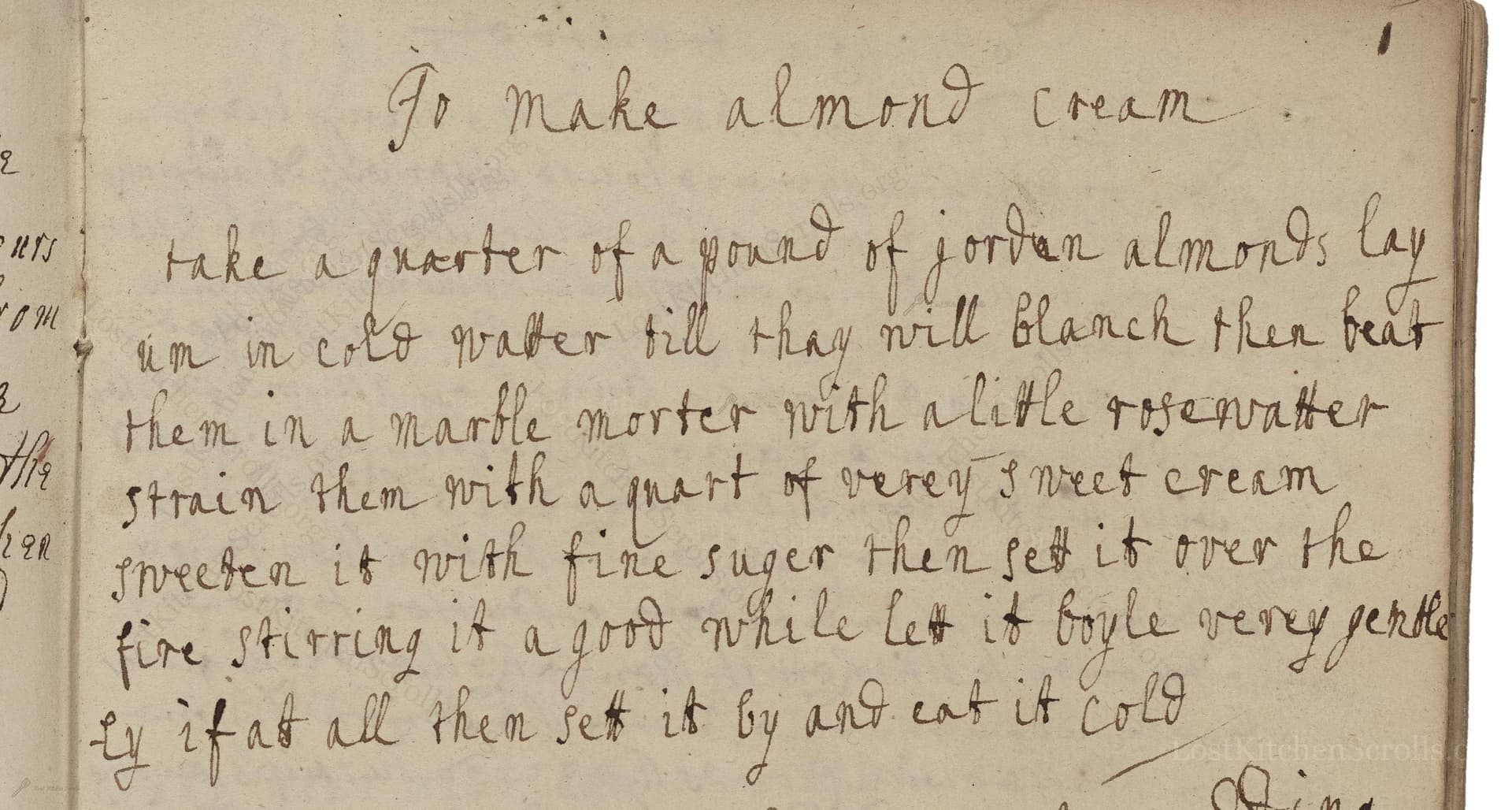To Make Almond Cream
From the treasured pages of Cookery book of Jane Webb, compiled by several people
Written by Jane Webb

To Make Almond Cream
"take a quarter of a pound of jordan almonds lay um in cold water till they will blanch then beat them in a marble morter with a litle rosewater strain them with a quart of verey sweet cream sweeten it with fine suger then sett it over the fire stirring it a good while let it boyle very gentle ly if at all then set it by and eat it cold"
Note on the Original Text
Recipes from this era were written for experienced cooks and lacked precise measurements or step-by-step instructions. Quantities were often described using household measures ('a quarter of a pound', 'a quart'), and temperature control relied on practical judgment ('let it boyle very gentle ly if at all'). Spelling was variable—'blanch', 'boyle', and 'suger' all reflect period forms. The instructional tone is direct and assumes familiarity with kitchen techniques like blanching almonds and straining mixtures. The recipe also exemplifies the period's affection for floral flavors, such as rosewater.

Title
Cookery book of Jane Webb, compiled by several people (1738)
You can also click the book image above to peruse the original tome
Writer
Jane Webb
Era
1738
Publisher
Unknown
Background
A delightful glimpse into the culinary world of early 18th-century England, this manuscript offers a playful array of recipes and kitchen wisdom, reflecting the tastes and ingenuity of its era.
Kindly made available by
Folger Shakespeare Library
This recipe dates from the early-to-mid 18th century, attributed to Jane Webb, an Englishwoman active between 1725 and 1750. Almond creams were popular desserts among the English elite, who prized delicate, perfumed dishes showcasing expensive ingredients such as almonds, sugar, and rosewater. These creams emerged alongside other custards and creams found on fashionable tables, reflecting the increased availability of sugar and exotic imports in Georgian Britain. The use of almond-based sweets such as this was a marker of wealth and sophistication, as both almonds and rosewater were imported luxury goods.

Cooks would have used a marble mortar and pestle for pounding the almonds to a fine paste. A fine strainer or muslin cloth helped strain the mixture, ensuring a smooth texture. For the cream, a large saucepan or posset pot would be gently heated over a hearth or stove, requiring attentive stirring with a wooden spoon. Once finished, the almond cream was set aside to cool, likely in ceramic or pewter serving dishes.
Prep Time
15 mins
Cook Time
15 mins
Servings
6
We've done our best to adapt this historical recipe for modern kitchens, but some details may still need refinement. We warmly welcome feedback from fellow cooks and culinary historians — your insights support the entire community!
Ingredients
- 4 ounces blanched Jordan almonds (sweet almonds; modern substitute: regular blanched almonds)
- 1 quart double cream (heavy cream)
- 1/2 cup caster sugar (fine sugar)
- 1 tablespoon rosewater (or to taste)
Instructions
- Begin by soaking 4 ounces of blanched sweet almonds (Jordan almonds) in cold water until the skins slip off easily.
- Drain and peel the almonds, then grind them finely in a mortar and pestle, adding a splash of rosewater to help the process.
- Once you have a smooth almond paste, combine it with 1 quart of fresh, very sweet cream.
- Stir in about 1/2 cup of caster sugar, or to your taste.
- Pour this mixture into a saucepan and gently warm over low heat, stirring continuously.
- Let it heat through and just barely simmer—avoid boiling rapidly as this could curdle the cream.
- Once thickened slightly and the flavors are blended, remove from heat, let cool, and serve chilled.
Estimated Calories
375 per serving
Cooking Estimates
It takes about 15 minutes to prepare the ingredients, and another 15 minutes to cook everything gently on the stove. Each serving has around 375 calories, and the recipe makes 6 servings.
As noted above, we have made our best effort to translate and adapt this historical recipe for modern kitchens, taking into account ingredients nowadays, cooking techniques, measurements, and so on. However, historical recipes often contain assumptions that require interpretation.
We'd love for anyone to help improve these adaptations. Community contributions are highly welcome. If you have suggestions, corrections, or cooking tips based on your experience with this recipe, please share them below.
Join the Discussion
Rate This Recipe
Dietary Preference
Culinary Technique

Den Bockfisch In Einer Fleisch Suppen Zu Kochen
This recipe hails from a German manuscript cookbook compiled in 1696, a time whe...

Die Grieß Nudlen Zumachen
This recipe comes from a rather mysterious manuscript cookbook, penned anonymous...

Ein Boudain
This recipe comes from an anonymous German-language manuscript cookbook from 169...

Ein Gesaltzen Citroni
This recipe, dating from 1696, comes from an extensive anonymous German cookbook...
Browse our complete collection of time-honored recipes



